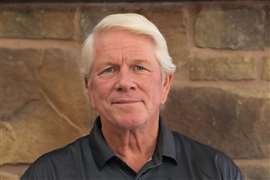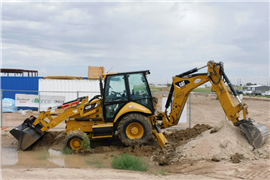How are construction OEMs adapting to the circular economy?
17 February 2023
Construction OEMs are hoping to meet new sustainability objectives with ambitious plans to increase the amount of remanufactured components they produce and the number of certified rebuilds by dealers. But is this enough to transition to a circular economy? Lucy Barnard investigates.
Towards the end of 2021, Sarah Jones, managing director of UK-based plant hire firm Stokey, began exploring the options for replacing the company’s venerable Caterpillar D9 bulldozer which the company had originally bought 14 years earlier and which had clocked up 22,000 machine hours working in quarries around the British Midlands.
Keen to ensure that customers avoided the chances of breakdowns associated with older machines, at first the company had planned to replace the tracked 50,000kg machine with a newer version and either sell off or scrap the old one.
But, inspired by a growing trend in business to reduce carbon emissions and improve its impact on the environment – as well as a wish to cut costs – Jones, like a growing number of other customers, chose to get local Caterpillar dealer Finning to strip down and rebuild the machine instead, replacing the worn parts with used ones which had been returned to a Cat factory and restored or ‘remanufactured’.
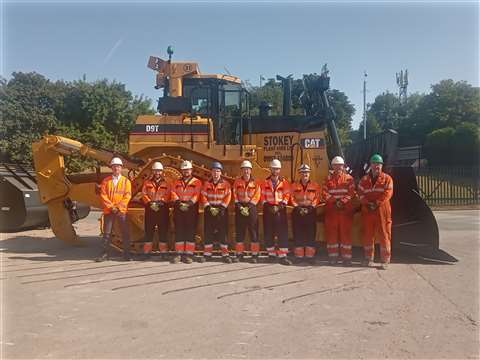 The Stokey team poses for a picture with the Finning UK team which completed the certified rebuild. Photo: Finning
The Stokey team poses for a picture with the Finning UK team which completed the certified rebuild. Photo: Finning
Stokey’s decision to choose a certified powertrain (CPT) rebuild, which includes replacing the transmission, engine, differential and final drives with remanufactured alternatives where possible, saved the customer a cool £550,000 compared with the costs of buying a new machine and saved the planet thousands of tonnes of carbon in terms of the energy and resources.
“We’re giving an old machine a completely new lease of life instead of sending it off for resale or worse still, to be broken down and scrapped,” Jones says, posing proudly with the rebuilt machine and sporting a hard hat and hi-vis orange jacket.
Of course, re-using, repairing and reconditioning expensive machinery is nothing new in the construction equipment industry. Independent repair shops, equipment dealers and manufacturers have been offering various levels of repair for well over a century.
But in recent years firms have started taking what has become an industry norm and making a direct connection with meeting company-wide sustainability objectives. Organisations can gain faster near-term value from bringing back existing products and reusing them and incorporating innovations that help achieve net zero and net neutral goals across supply chains.
Caterpillar’s dealers have been running a certified rebuilds programme since 1985, carrying out on each machine over 350 tests and examining 7,000 parts to provide customers with a like-new machine, complete with Cat warranty.
Certified Rebuilds
Mark Holden, product support account manager at Finning UK & Ireland, says that by re-using the most hard-wearing parts of the machine and replacing only the parts which needed it, Stokey’s rebuild cost the company £300,000 (€339,500) compared with the £850,000 o buy a new equivalent D9 dozer. And the rebuilt dozer also costs the planet less in terms of the amount of raw materials and carbon used to make it.
“While the engine, transmission and other key components will eventually need replacing before they fail and cause operational issues, the main chassis and body of the machine is structurally sound so can be stripped back and restored to its former glory and used again and again,” he says.
|
The Stokey rebuild 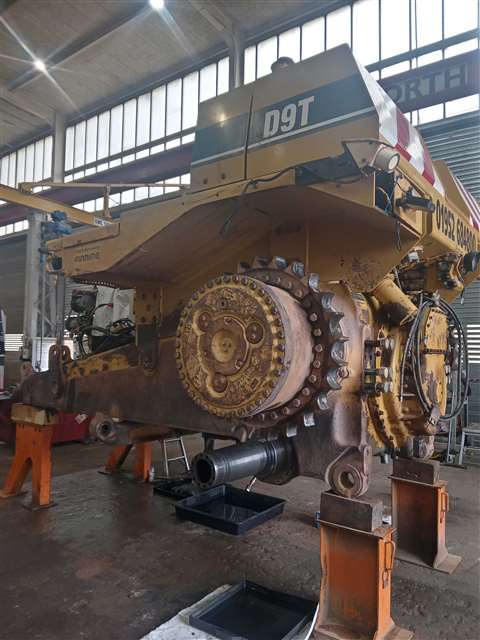
In the case of Stokey’s D9 bulldozer rebuild, the entire process lasted from April until June 2022, starting with a pre-repair inspection carried out by Finning lead service engineer Lane Armstrong and was followed by a month-long workshop strip down during which two engineers painstakingly disassembled all external and internal components and sorted through them. A third stage comprises an in-depth inspection of the machine, looking along the chassis, inspecting the state of the hose work and identifying any damage to the mounts or brakes. Only after this are the technicians able to provide a recommendation for a full scope of work required and provide a cost and timetable to the customer. Once agreed, service controller Simon Benton then oversaw the project, ordering in the major components including a remanufactured engine from Caterpillar as well as using Finning service exchange units for components such as final drive units. Photo: Finning |
Remanufacturing is becoming more and more important within the sustainability goals of OEMs and their dealers.
It means that rather than replacing the D9’s worn engine with a new one, taking up more valuable material and resources, engineers can get hold of a used engine from a previous customer which has been shipped back to the manufacturer and restored to original factory conditions before being returned to the dealer and re-sold at a cheaper price than a new one but offering the same performance and with a manufacturer’s warranty to match.
As well as being the world’s largest construction equipment manufacturer, Caterpillar is also one of the world’s largest remanufacturers, officially offering the service since 1973. And before that, the company boasts that it has been carrying out refurbishments and repairs. It points out that one of the original tractors built by Cat’s predecessor company, Holt Manufacturing Company in 1917, is still in operation today. Components can be remanufactured up to six times.
What is remanufacturing?
Over the last 40 years Cat says its dealers have rebuilt an estimated 37,000 machines, powertrains and components and in 2021 alone they returned 127 million pounds of material to Cat remanufacturing facilities for processing. The sales price of Cat Reman products includes a ‘core deposit’ worth around the same as the value of the materials themselves, which the manufacturer says provides an economic incentive to eventually return the component.
In 2021 the company announced a sustainability goal to increase sales and revenue from Cat Reman by 25% by 2030 from 2018 levels.
The reasons behind this are both environmental and strategic.
Cat says that restoring a cylinder head to factory conditions requires 85% less energy than manufacturing a new one, generating 61% fewer greenhouse gasses. It also uses 86% less water and requires 85% less material. Remanufactured engines are sent to dealers who then use them as part of a comprehensive rebuild.
Moreover, the company estimates that around 35% of its costs lie in overheads, while the majority (65%) are materials costs. So salvaging materials gives a greater business advantage for the company over its competitors.
 Ellen MacArthur delivers a speech during the Renault Nissan Group’s shareholders general meeting in Paris, France. Photo: Stephane Lemouton
Ellen MacArthur delivers a speech during the Renault Nissan Group’s shareholders general meeting in Paris, France. Photo: Stephane Lemouton
The Ellen MacArthur Foundation, a UK-based charity set up by the former British yachtswoman to promote the circular economy, singles out both Caterpillar and aerial platform manufacturer JLG as examples of companies which are successfully moving towards a circular economy by adopting innovative business models.
The foundation cites Caterpillar for providing customers with “multiple product life extension options,” including remanufacturing, rebuilding and second-hand sales.
“The circular economy framework places emphasis on the importance of designing effective products and systems rather than aiming solely for efficiency.
“Caterpillar have employed this strategy in their own product design, and rather than aiming to use less and less material, increasing amounts of consideration goes into creating a product that is intended to be remanufactured a number of times,” the foundation says.
Cat boasts that its equipment is ‘built to be rebuilt’. One of its most cited examples is an engine block with a removable sleeve in the cylinder bore. When the component is recovered, this material can be removed and replaced to return the engine to as-new performance. Previous techniques for remanufacturing engine blocks have involved re-boring the engine cylinder and using a larger piston, but this can only be done up to three times before the quality of the product is affected.
And it’s not just Caterpillar which has big plans to harness the circular economy more. Other manufacturers have also recently announced ambitious growth targets for their own remanufacturing and rebuilding operations.
Volvo Construction Equipment has a target of increasing its remanufacturing business by 60% by 2025 compared with a 2018 baseline. The company also says it expects to see a big growth in its certified rebuilds, driven by sustainability goals, cost-saving initiatives and by the recent supply chain crisis which has made it difficult to get hold of new machines.
Harnessing the circular economy
“We expect to see a significant increase in the number of certified rebuilds carried out in 2023 compared to 2022,” says Hilton Wood, Pennsylvania-based product manager for sales development and aftermarket products and services at Volvo CE. Compared with previous years, rebuilds are receiving more attention and quoting activity is increasing due to tight availability and high demand for machines. An added benefit is the sustainability aspect.”
Hitachi Construction Machinery too reports that customers are increasingly considering refurbishing their own equipment. The company has remanufacturing facilities in 21 locations around the world in ten countries, employing approximately 400 people.
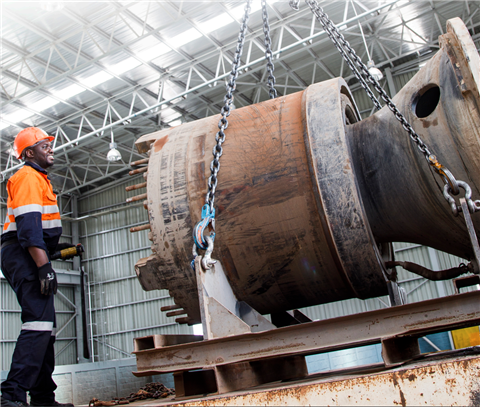 Remanufacturing at a Hitachi reman facility in Zambia. Photo: Hitachi CM
Remanufacturing at a Hitachi reman facility in Zambia. Photo: Hitachi CM
“Cost is undoubtedly a main driver but we are noticing an increasing interest in the circular economy, especially in Scandinavian countries,” says Rob Feskens, parts sales representative at Hitachi Construction Machinery.
“This is often stimulated and driven by government regulations put in place to encourage contractors to work in a more environmentally and sustainable manner.”
The Ellen MacArthur Foundation praises JLG’s partnership with finance company DLL which encourages customers to return equipment to JLG at the end of their lease contracts, allowing JLG to plan and predict when assets will reach its workshop for reconditioning.
“JLG’s reconditioned business pipeline for 2023 is very strong,” says Chris Mellott, VP of sales & service at JLG. “Since the program launched in 1997, it has grown through all economic conditions, regardless of the market conditions (supply chain constraints, looming recession, etc).”
Manufacturers are also highlighting retrofitting services too as another way of extending the life of machinery whilst also reducing carbon emissions.
In February, French OEM Manitou announced that it had signed a deal with rental company Kiloutou to investigate retrofit electrification kits for the manufacturer’s diesel-powered telehandlers. The kits, which will comprise lithium-ion batteries, will open the door to switching from internal combustion to low carbon full electric motors.
“The possibility of giving machines in our fleet a second life, and lowering their emissions, is a key lever in our drive to reduce our indirect emissions,” said François Renault, group fleet and sustainability director of Kiloutou Group. “We are working particularly hard these days to fast track this circular economy solution.”
Extending the life of construction equipment
German construction equipment manufacturer Liebherr reports a similar trend. “Since 2022, we have noticed an increase in customer requests for upgrades and overhauls,” says Wolfgang Pfister, head of strategic marketing and communications at Liebherr.
“What is striking is that customers are looking to apply their machines for a wider range of operations. To stay competitive, our customers require more versatile and multi-purpose machines. The current train of thought is definitely also heading towards longevity and sustainability. The global awareness of green thinking is constantly growing.”
Yet, despite these grand sounding plans, some remain sceptical whether growing remanufacturing businesses is achievable – or even desirable – for OEMs.
One of the key reasons for this is that current rebuilding and remanufacturing practices are highly people intensive. Although much of the construction process for new machinery is automated and done by robotics, disassembly is still done by hand, with engineers inspecting each piece to decide which can be re-used or salvaged for remanufacture and which can only be scrapped.
The nature of the process means that remanufacturing is only currently profitable for the most valuable components such as steel engine components or gears. Even amongst this group, not all components are suitable for remanufacturing, with many too worn or degraded to be considered worthwhile repairing.
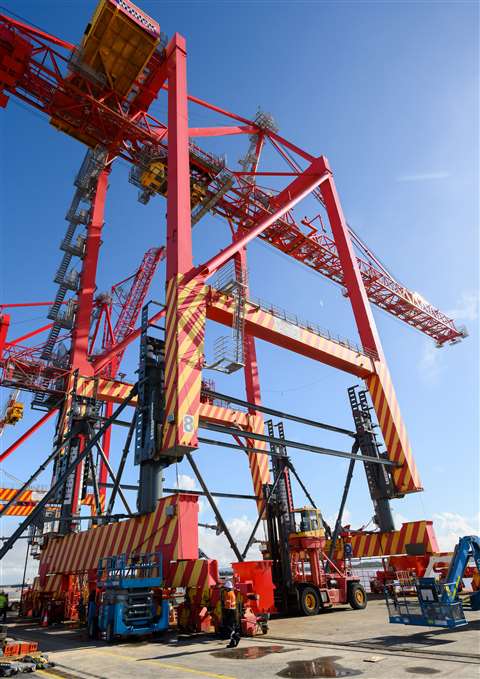 Liebherr deployed a new patented jacking system for lift height extensions in 2022 as part of its Liebherr Transform programme. Photo: Liebherr
Liebherr deployed a new patented jacking system for lift height extensions in 2022 as part of its Liebherr Transform programme. Photo: Liebherr
Liebherr estimates that remanufacturing results in savings in material of between 75% and 78%, resulting in a reduction in the carbon footprint of a crankshaft by 66% and a crankcase by 61%.
However, the researchers calculate that when rejects are taken into account, the reductions in carbon footprint for both remanufactured elements falls to around half that of its newly manufactured equivalent.
Similarly, the actual remanufacturing processes can also be inefficient and carbon intensive, with cast iron components often requiring welding at pre-heat temperatures greater than 315°C.
And, with most manufacturers only using a few facilities to provide the service globally, many heavy components must be transported long distances, which also adds to their carbon footprint.
Remanufacturing research projects
In order to find ways to increase the amount of material which can easily be remanufactured - and more effective and energy efficient ways of doing it - OEMs and governments are investing heavily in research and development.
The REMADE Institute, a public-private partnership established by the US department of Energy as well as OEMs including Caterpillar, John Deere, Michelin and Nike and academic research institutions such as MIT, Rochester Institute of Technology and Yale, has since 2017 handed out millions of dollars in research grants aimed at looking at just these issues.
Current projects include working with remanufacturing firms to come up with a set of design guidelines which would allow design engineers to integrate remanufacturing considerations into their components in the first place, as well as using machine learning techniques to recognise different types of component damage and to develop a real-time estimate of remanufacturing costs.
Researchers in the Rochester Institute of Technology and the University of Pittsburgh are collaborating with Caterpillar on a wide range of projects aimed at increasing the proportion of worn steel components which can be remanufactured such as developing high-tech practical repair techniques to relieve stress in components which are currently unusable and using high speed laser cladding for remanufactured crankshafts and camshafts which is expected to increase the reuse rate from 70% to 95%. The partners are also developing a robust weld repair process that can be achieved at lower temperatures.
Furthermore, the institute is funding research aimed at increasing the range of materials which can be repaired or remanufactured. These include using micro abrasion techniques or laser abrasion to remove the potting material surrounding circuit boards and using automated methods to detect solder joint and interconnection failures on used electronics.
And yet, despite all of this, remanufacturing comprises just a fraction of the business, with most OEMs firmly focused on the more lucrative process of making and selling machines.
Caterpillar’s goal to increase sales and revenue from Cat Reman by 25% by 2030 from 2018 levels comes after the company came short on a previous sustainability goal to grow remanufacturing revenue by 20% from 2013 to 2020 – something the company explained on a fall in overall demand during the first year of the Covid pandemic and on the company’s decision to stop manufacturing on-highway truck engines. The company does not disclose separate remanufacturing revenues.
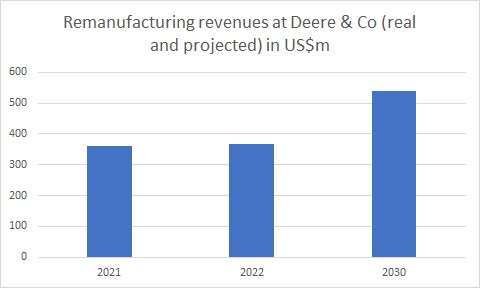
Agricultural and construction equipment maker Deere & Co, which does disclose the figures from its remanufacturing division, said that revenues stood at $360.4m in 2021 – less than 1% of the company total during the period.
Under Deere’s latest sustainability targets, it plans to grow that figure by 50% to reach $540.6m by 2030. Progress so far is modest: in 2022, the company said revenues from the division grew by 2% to £367.6m.
Bert Avezaat, director of Dutch crane repair specialist Avezaat which specialises in repairing cranes from any manufacturer, says that although the demand for repairs, rebuilds and remanufacturing is getting stronger, businesses like his see little in terms of competition from OEMs who are mostly still concerned with a linear economy model of manufacturing and selling as many new machines as possible for profit.
“In general, the OEMs are more focused on supplying new cranes or parts,” he says. “They carry out repairs but it is not their main business.”
Manufacturers’ focus is still the linear economy
Some customers also remain wary of remanufactured products, preferring the reassurance and prestige of a new product. According to Alexander Pajari, product support director for Volvo CE, raising awareness of the remanufacturing process is a challenge for the manufacturer in China, for example, where any second hand items are traditionally viewed with suspicion.
Moreover, some may worry that by focusing so much on remanufacturing successes in their sustainability goals, OEMs may distract attention from setting goals to cut their own significant carbon footprints. Manufacturers are coming under increasing pressure to slash emissions in line with the Paris Agreement – a process which is likely to cause significant disruption to current working practices.
But back at Finning’s workshop in the West Midlands, Stokey’s Sarah Jones has been converted.
“This experience has certainly opened our eyes to the prospect of considering more rebuilds – both in terms of the financial gains over replacing with a new machine, but with sustainability in mind as well,” she says.
STAY CONNECTED



Receive the information you need when you need it through our world-leading magazines, newsletters and daily briefings.
CONNECT WITH THE TEAM










